Unit 6 Nature in words Understanding ideas(共44张,内嵌视频)-高中英语外研版(2019)选择性必修第三册(共45页PPT)
文档属性
| 名称 | Unit 6 Nature in words Understanding ideas(共44张,内嵌视频)-高中英语外研版(2019)选择性必修第三册(共45页PPT) |
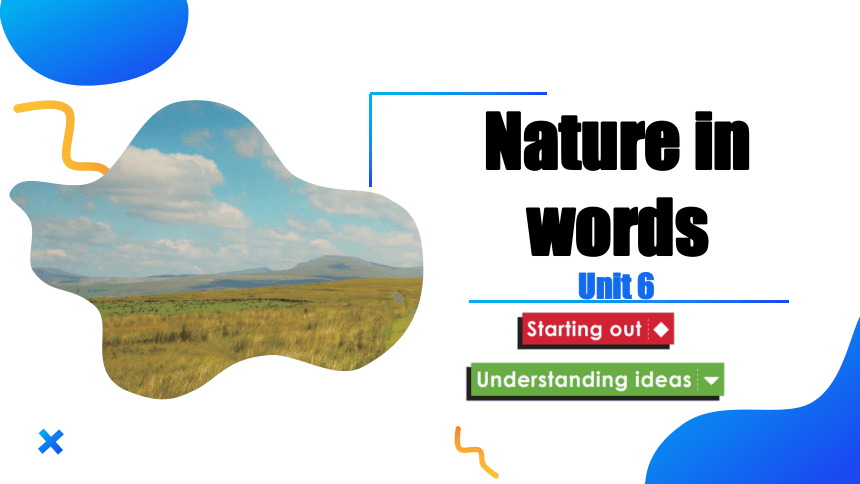
|
|
| 格式 | pptx | ||
| 文件大小 | 20.1MB | ||
| 资源类型 | 教案 | ||
| 版本资源 | 外研版(2019) | ||
| 科目 | 英语 | ||
| 更新时间 | 2025-04-01 22:18:07 | ||
图片预览

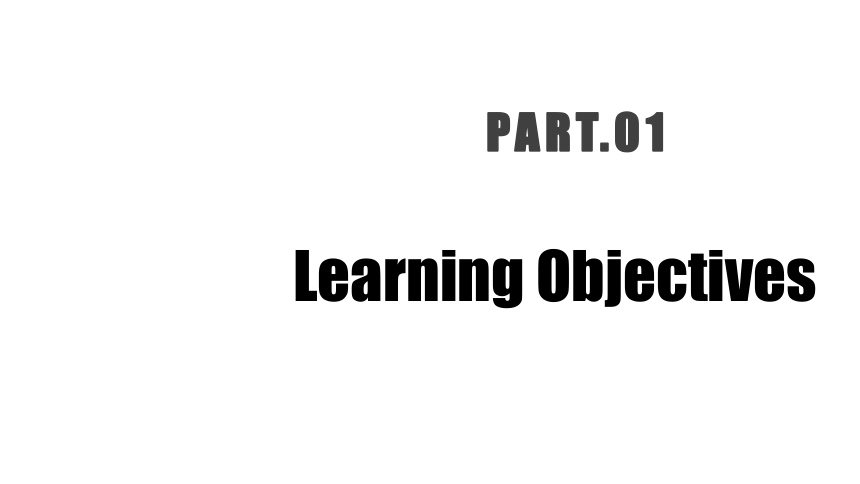
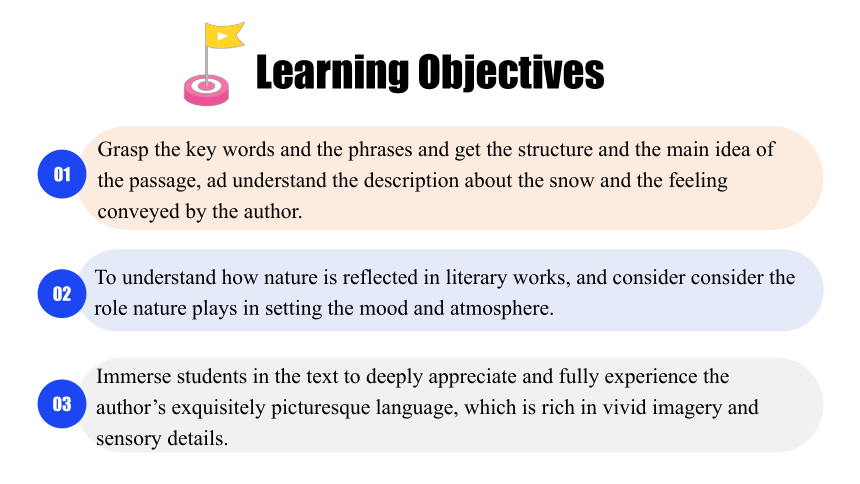
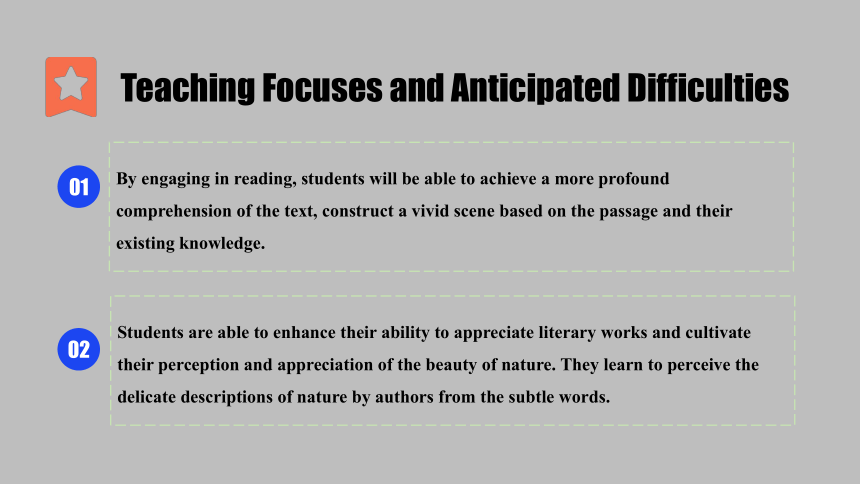
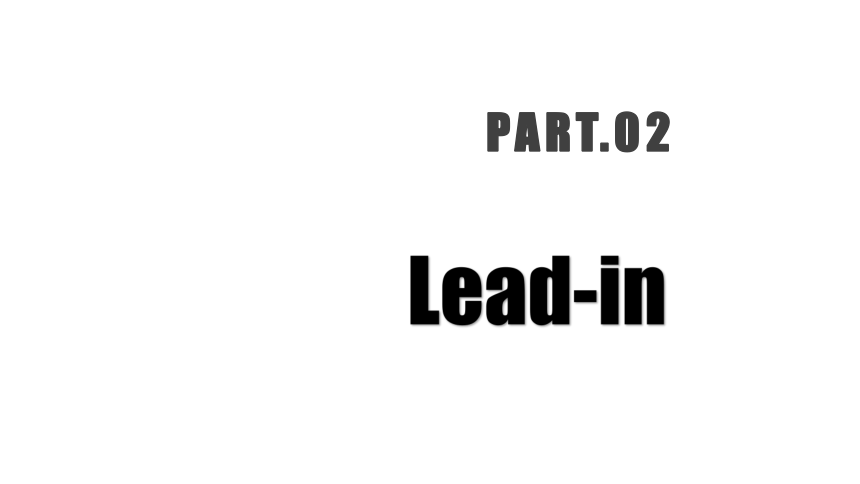
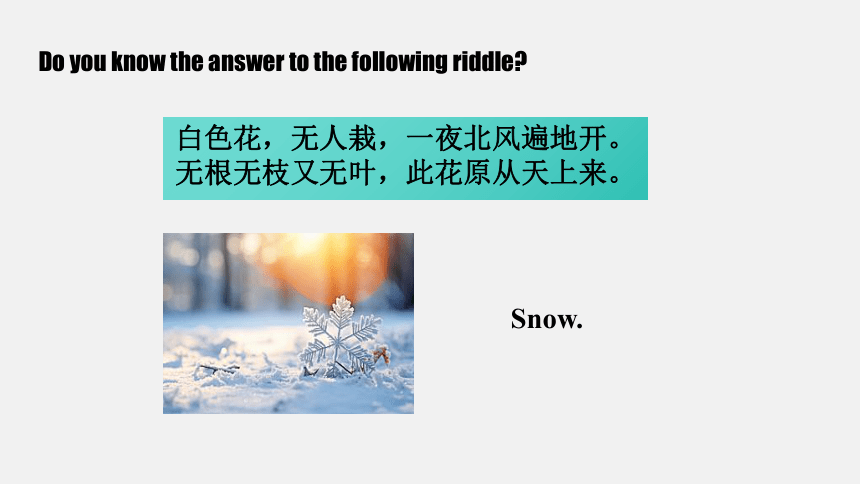
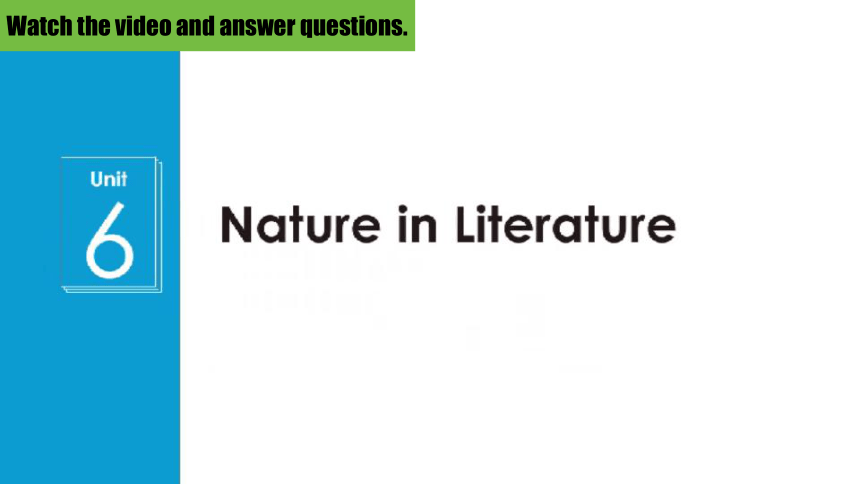
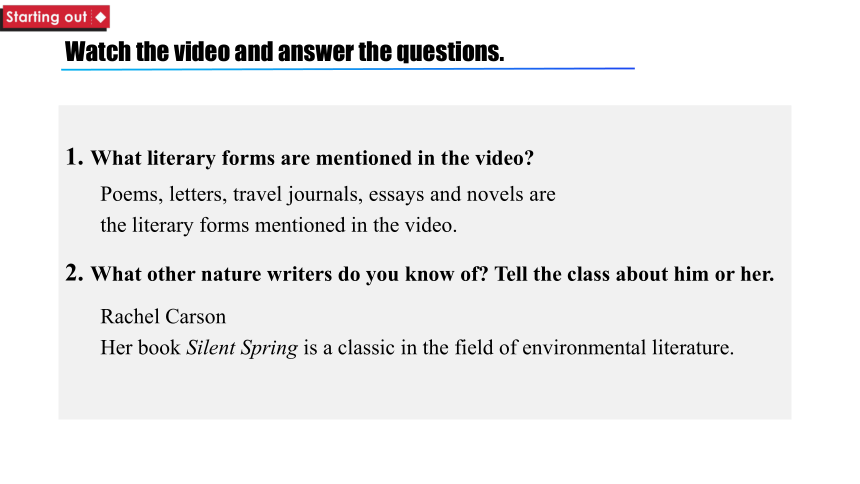
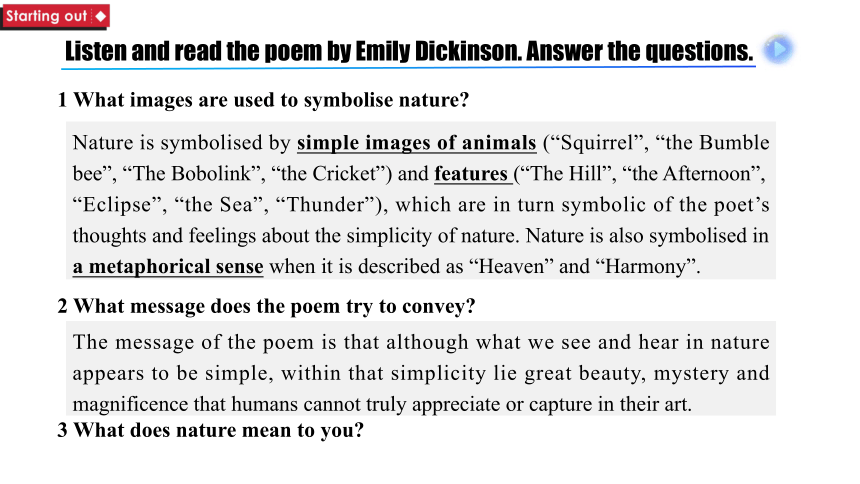
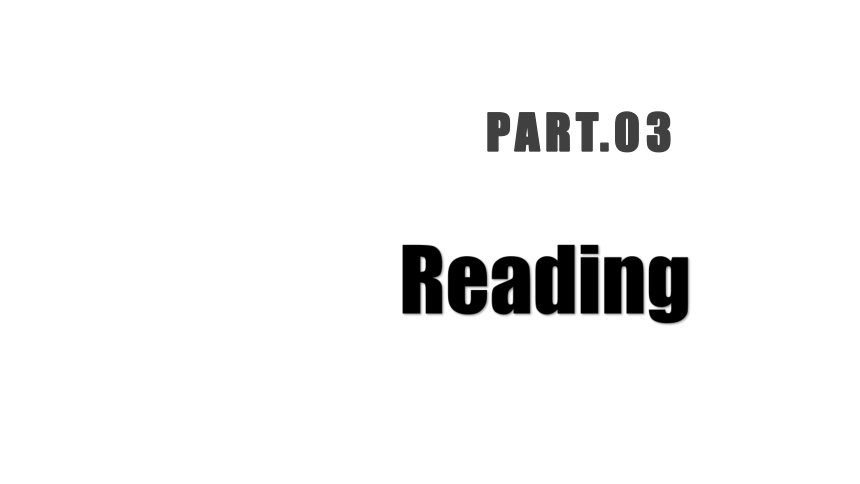
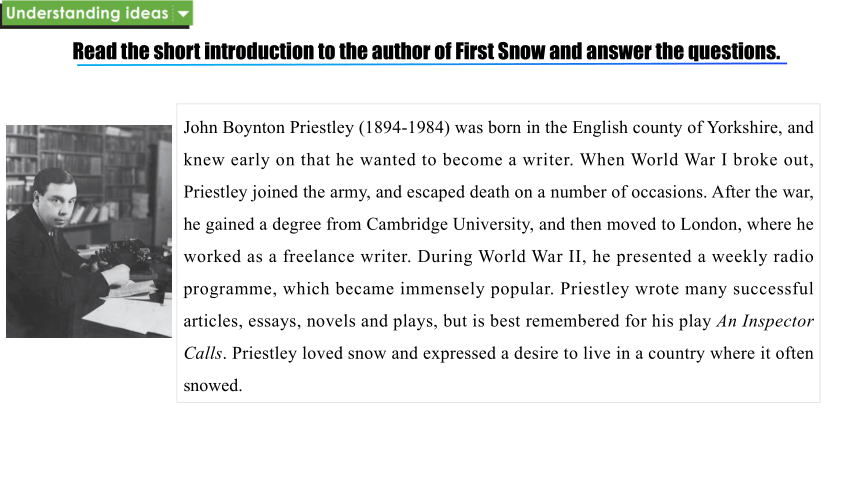
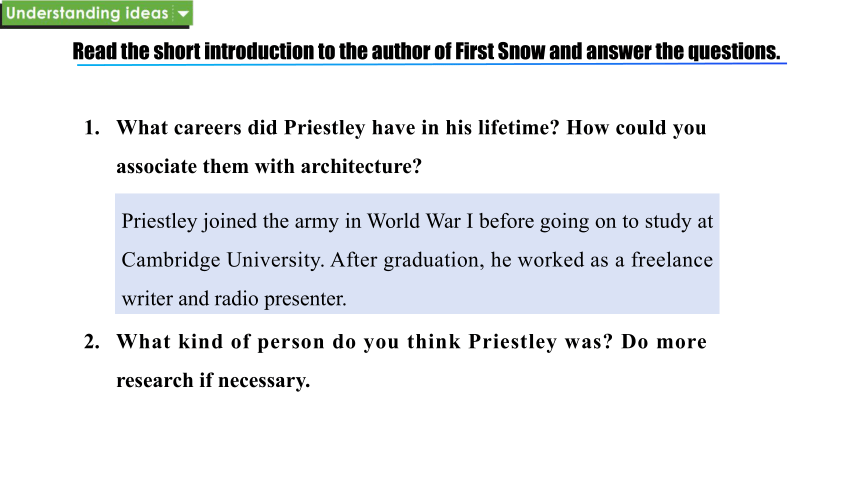
文档简介
(共44张PPT)
Unit 6
Nature in
words
PART.01
Learning Objectives
Grasp the key words and the phrases and get the structure and the main idea of the passage, ad understand the description about the snow and the feeling conveyed by the author.
01
Immerse students in the text to deeply appreciate and fully experience the author’s exquisitely picturesque language, which is rich in vivid imagery and sensory details.
03
To understand how nature is reflected in literary works, and consider consider the role nature plays in setting the mood and atmosphere.
02
Learning Objectives
By engaging in reading, students will be able to achieve a more profound comprehension of the text, construct a vivid scene based on the passage and their existing knowledge.
Students are able to enhance their ability to appreciate literary works and cultivate their perception and appreciation of the beauty of nature. They learn to perceive the delicate descriptions of nature by authors from the subtle words.
01
02
Teaching Focuses and Anticipated Difficulties
PART.02
Lead-in
Do you know the answer to the following riddle
白色花,无人栽,一夜北风遍地开。无根无枝又无叶,此花原从天上来。
Snow.
Watch the video and answer questions.
Watch the video and answer the questions.
01
1. What literary forms are mentioned in the video
2. What other nature writers do you know of Tell the class about him or her.
Poems, letters, travel journals, essays and novels are the literary forms mentioned in the video.
Rachel Carson
Her book Silent Spring is a classic in the field of environmental literature.
Listen and read the poem by Emily Dickinson. Answer the questions.
02
1 What images are used to symbolise nature
2 What message does the poem try to convey
3 What does nature mean to you
Nature is symbolised by simple images of animals (“Squirrel”, “the Bumble bee”, “The Bobolink”, “the Cricket”) and features (“The Hill”, “the Afternoon”, “Eclipse”, “the Sea”, “Thunder”), which are in turn symbolic of the poet’s thoughts and feelings about the simplicity of nature. Nature is also symbolised in a metaphorical sense when it is described as “Heaven” and “Harmony”.
The message of the poem is that although what we see and hear in nature appears to be simple, within that simplicity lie great beauty, mystery and magnificence that humans cannot truly appreciate or capture in their art.
PART.03
Reading
Read the short introduction to the author of First Snow and answer the questions.
01
John Boynton Priestley (1894-1984) was born in the English county of Yorkshire, and knew early on that he wanted to become a writer. When World War I broke out, Priestley joined the army, and escaped death on a number of occasions. After the war, he gained a degree from Cambridge University, and then moved to London, where he worked as a freelance writer. During World War II, he presented a weekly radio programme, which became immensely popular. Priestley wrote many successful articles, essays, novels and plays, but is best remembered for his play An Inspector Calls. Priestley loved snow and expressed a desire to live in a country where it often snowed.
Read the short introduction to the author of First Snow and answer the questions.
01
What careers did Priestley have in his lifetime How could you associate them with architecture
Priestley joined the army in World War I before going on to study at Cambridge University. After graduation, he worked as a freelance writer and radio presenter.
What kind of person do you think Priestley was Do more research if necessary.
Describe snow in your own words. Then read the passage and underline the expressions the author uses to describe the first snow.
02
When snow starts to fall, the sky opens, releasing a gentle flurry of delicate, crystalline flakes. Each snowflake is a unique masterpiece with an intricate design.
The expressions used by the author to describe the first snow: an event, so fantastically carpeted, a magical event, a cold place of dead white and pale blues, faintly flushed, artfully disposed, a cold sparkle of white and blue,
falling heavily, in great soft flakes...
The passage can be divided into _______ parts.
3
introduction
description
What type of text is this passage
A.Narration. B.Argumentation.
C.Exposition. D.Essay.
How does the passage mainly develop
A.By listing numbers. B.By following the order of time.
C.By making a comparison. D.By giving examples.
Skim the passage and answer the questions.
Underline the expressions the author used to describe the first snow.
Para. 1-2 introduction of the scenery of the snow
First Snow
Para. 3-5 description of the scenery of the snow
fantastically carpeted
a magical event
When I got up this morning...
The sun came out...
An hour or two later...
Now...
time order
Para._____
Skim the passage and match the main idea of each paragraph.
1
A. The changes happened now.
C. The prospect one hour or two later.
E. The first snow is a magical event.
Para._____
Para._____
Para._____
Para._____
B. The scenery of the snow when the author got up.
D. The author’s feeling about the last night’s fall of snow.
2
3
4
5
1 By describing the magical scenery of the first snow, the author encourages readers
to come to England and experience its beauty for themselves.
2 By depicting the beautiful, near-magical scenery of the first snow, the author wants to convey his love for snow.
3 By recalling his memories as a child during the first snow, the author expresses his
longing for the innocent happiness of childhood.
Choose the author’s purpose in writing the passage and give your reasons.
03
Mr Robert Lynd once said of Jane Austen’s characters that they are people in whose lives a slight fall of snow is _________.
Read the introduction and answer the questions.
The author’s reference to Robert Lynd’s comment about Jane Austen’s characters serves to ______.
A. emphasize the significance of snow in ordinary life
B. introduce the theme of snow in Austen’s works
C. show the contrast between Austen’s time and now
D. criticize the over-reaction to snow in Austen’s stories
an event
The author was nearly as excited about the snow this morning as the __________.
Read the introduction and answer the questions.
The author’s excitement about the snow indicates that ______.
A. adults can also be deeply affected by simple natural phenomena
B. the snowfall was extremely rare in the area
C. the author has a childish personality
D. the snowfall was a sign of good luck
children
The first fall of snow is not only an event but a __________ event.
Read the introduction and answer the questions.
The author emphasizes that the first fall of snow is a “magical event” mainly to ______.
A. describe the beauty of the snow
B. explain why it is so rare
C. compare it with other natural phenomena
D. show the unique experience it brings
magical
Timeline
When I got up this morning…
The sun came out…
An hour or two later…
Now…
The world became a 1 ___________________
____________. The light coming through the windows seemed quite strange, and it made the familiar business of splashing and shaving and brushing and dressing very strange too.
cold place of dead white
and pale blues
Scenery 1
04
The author uses picturesque language to depict the first plete the diagram with the expressions you have underlined in the passage.
When the author got up this morning, ____________ was a cold place of
dead white and pale blues.
Read the introduction and answer the questions.
Why did the light coming through the windows make the familiar daily activities seem strange
A. Because the light was too bright.
B. Because the author was in a bad mood.
C. Because the light had an unusual quality.
D. Because the author was half - asleep.
the world
The author uses picturesque language to depict the first plete the diagram with the expressions you have underlined in the passage.
Timeline
The snow became 2 __________. My dining-room window changed into 3 _____________ ______. The little plum tree outside, with snow 4 _______________________________
____________ stood in full sunlight.
lining its branches and artfully disposed
a lovely Japanese
Scenery 2
print
along its trunk
delicate pinks
When I got up this morning…
The sun came out…
An hour or two later…
Now…
04
After the sun came out, it was shining bravely and tinting the snow
with ________ pinks.
Read the introduction and answer the questions.
The description of the sun “shining bravely and flushing the snow with delicate pinks” is used to ______.
A. show the intensity of the sunlight
B. create a vivid and enchanting visual image
C. imply that the weather was about to change again
D. contrast with the earlier cold and strange atmosphere
delicate
Timeline
Everything was a 5 _____________________. The ground 6 _______________, the sky was 7 _________, and all the trees 8 ___________
__________________. The entire scene looked 9 _________________.
so many black
went on and on
Scenery 3
thick grey
cold sparkle of white and blue
and threatening shapes
like a cruel grassland
When I got up this morning…
The sun came out…
An hour or two later…
Now…
The author uses picturesque language to depict the first plete the diagram with the expressions you have underlined in the passage.
04
Looking out of the study window, the author saw the ground extending, the sky being thick grey, and all the trees as many ______ and threatening shapes.
Read the introduction and answer the questions.
Why does the author describe the trees as “black and threatening shapes”
A. Because the trees were actually dying and looked menacing.
B. Because the thick grey sky made the trees appear darker and more ominous.
C. Because the author was in a bad mood and saw the trees that way.
D. Because there were real threats lurking among the trees.
black
Timeline
The snow is 10 ________________________ The roofs are 11 _________. The trees are 12___________. I can see the children flattening their noses against the window.
thick
Scenery 4
all bending
falling heavily in great soft flakes.
When I got up this morning…
The sun came out…
An hour or two later…
Now…
The author uses picturesque language to depict the first plete the diagram with the expressions you have underlined in the passage.
04
The glare has disappeared and no ______ of the disturbing remains.
Read the introduction and answer the questions.
The description of the change from “the disturbing” scene to the current one where “the glare has gone” shows that ______.
A. the weather changes quickly and randomly
B. the author’s mood has improved along with the change of the landscape
C. the different states of the snowfall create distinct atmospheres
D. the earlier disturbing feeling was just an illusion
touch
1. Why does the author mention Jane Austen at the beginning of the passage
Think & Share
Talk with your partner.
By referencing the characters of jane Austen, who is known for her witty, perceptive observations of early 19th century English
country life, the author is emphasising the irony and self-awareness with which he goes on to make his statement about the first snow.
2. What images does the author use to enhance the description of snow
Think & Share
Talk with your partner.
Images used by the author to enhance the description of snow: a cold place of dead white and pale blues, flushing the snow with delicate pinks, a cold sparkle of white and blue, falling
heavily, in great soft flakes...
3. What other literary works about snow do you know Share them with the class.
Think & Share
Talk with your partner.
A Visit to Secretary Wu’s House by Cen Shen:
The sentence “Suddenly, as if a spring breeze had come overnight, thousands of pear trees were in bloom” is a classic description of snow.
4. Have you encountered any difficulties in understanding this
passage Can you use visualisation to better understand the passage
1. talk away
talk back 顶嘴;反驳
talk down 说服;驳倒;以居高临下的口气说话
talk over 详细地商议;讨论;说服
练习:
The two friends sat on the bench and ________ away happily.
talked
2. come round
come across 偶然遇见;无意中发现;被理解
come about 发生;产生
come by 经过;获得;得到
练习:
The spring festival __________ round once a year.
comes
3. insist
insist on/upon + n. / v-ing 坚持要求、坚持做某事
insist that + 宾语从句 表示 “坚持要求” 时,从句要用虚拟语气
表示 “坚持认为” 时,从句根据实际情况使用时态
insistence n. 坚持;坚决主张
insistent adj. 坚持的;持续的;迫切的
练习:
His _______________ on doing it his way made others unhappy.
insistence
4. bend
bending n. 弯曲;弯曲度 adj. 弯曲的
bent adj. 弯曲的;驼背的;不诚实的
bend over 弯腰;俯身
bend down 俯身;蹲下
bend one’s knees 屈膝;下跪
around the bend 在拐弯处
练习:
He ________ his knees to beg for forgiveness.
bent
5. carpet
red carpet 红地毯;隆重的接待
roll out the red carpet for sb 隆重欢迎某人;热烈款待某人
sweep sth. under the carpet 把某事掩盖起来;隐瞒某事
练习:
The ground was __________ with fallen leaves.
carpeted
6. prospect
prospective adj. 预期的;未来的;可能的
prospector n. 勘探者;探矿者
in prospect 可期待;有…… 希望;在考虑中
open up prospects for 为…… 开辟前景
练习:
The _____________ found a large deposit of copper.
prospector
PART.04
Exercise
Exercise
1.Jim was listening attentively to the lecture, all his attention _______ (fix) on it.
2.The problem _____________ (discuss) at the meeting now is how to cut back
on the cost.
3._______ a certain extent, the kids have gained a sense of belonging.
4.It was full of clear cool water, and it __________ (sparkle) like a giant emerald in
the sun long ago.
5.With the sunlight __________ (glare), the children were having so much fun.
fixed
sparkled
being discussed
To
glaring
Exercise
6. When I was a kid, I lived with my grandma and she sang ______ (儿歌) to me every night.
7. John smiled ________ (faint) and asked her to come in.
8. She insisted _________ going to the party alone.
9. If you have any problem, please call our ___________ (inspect), and they will get to the scene immediately.
10. Children will lose their __________ (innocent) as they grow older.
faintly
rhymes
innocence
on/upon
inspectors
PART.05
Homework
Homework
1. summarise what we have learnt in this lesson;
2. prepare for the next lesson
See you next class!
Unit 6
Nature in
words
PART.01
Learning Objectives
Grasp the key words and the phrases and get the structure and the main idea of the passage, ad understand the description about the snow and the feeling conveyed by the author.
01
Immerse students in the text to deeply appreciate and fully experience the author’s exquisitely picturesque language, which is rich in vivid imagery and sensory details.
03
To understand how nature is reflected in literary works, and consider consider the role nature plays in setting the mood and atmosphere.
02
Learning Objectives
By engaging in reading, students will be able to achieve a more profound comprehension of the text, construct a vivid scene based on the passage and their existing knowledge.
Students are able to enhance their ability to appreciate literary works and cultivate their perception and appreciation of the beauty of nature. They learn to perceive the delicate descriptions of nature by authors from the subtle words.
01
02
Teaching Focuses and Anticipated Difficulties
PART.02
Lead-in
Do you know the answer to the following riddle
白色花,无人栽,一夜北风遍地开。无根无枝又无叶,此花原从天上来。
Snow.
Watch the video and answer questions.
Watch the video and answer the questions.
01
1. What literary forms are mentioned in the video
2. What other nature writers do you know of Tell the class about him or her.
Poems, letters, travel journals, essays and novels are the literary forms mentioned in the video.
Rachel Carson
Her book Silent Spring is a classic in the field of environmental literature.
Listen and read the poem by Emily Dickinson. Answer the questions.
02
1 What images are used to symbolise nature
2 What message does the poem try to convey
3 What does nature mean to you
Nature is symbolised by simple images of animals (“Squirrel”, “the Bumble bee”, “The Bobolink”, “the Cricket”) and features (“The Hill”, “the Afternoon”, “Eclipse”, “the Sea”, “Thunder”), which are in turn symbolic of the poet’s thoughts and feelings about the simplicity of nature. Nature is also symbolised in a metaphorical sense when it is described as “Heaven” and “Harmony”.
The message of the poem is that although what we see and hear in nature appears to be simple, within that simplicity lie great beauty, mystery and magnificence that humans cannot truly appreciate or capture in their art.
PART.03
Reading
Read the short introduction to the author of First Snow and answer the questions.
01
John Boynton Priestley (1894-1984) was born in the English county of Yorkshire, and knew early on that he wanted to become a writer. When World War I broke out, Priestley joined the army, and escaped death on a number of occasions. After the war, he gained a degree from Cambridge University, and then moved to London, where he worked as a freelance writer. During World War II, he presented a weekly radio programme, which became immensely popular. Priestley wrote many successful articles, essays, novels and plays, but is best remembered for his play An Inspector Calls. Priestley loved snow and expressed a desire to live in a country where it often snowed.
Read the short introduction to the author of First Snow and answer the questions.
01
What careers did Priestley have in his lifetime How could you associate them with architecture
Priestley joined the army in World War I before going on to study at Cambridge University. After graduation, he worked as a freelance writer and radio presenter.
What kind of person do you think Priestley was Do more research if necessary.
Describe snow in your own words. Then read the passage and underline the expressions the author uses to describe the first snow.
02
When snow starts to fall, the sky opens, releasing a gentle flurry of delicate, crystalline flakes. Each snowflake is a unique masterpiece with an intricate design.
The expressions used by the author to describe the first snow: an event, so fantastically carpeted, a magical event, a cold place of dead white and pale blues, faintly flushed, artfully disposed, a cold sparkle of white and blue,
falling heavily, in great soft flakes...
The passage can be divided into _______ parts.
3
introduction
description
What type of text is this passage
A.Narration. B.Argumentation.
C.Exposition. D.Essay.
How does the passage mainly develop
A.By listing numbers. B.By following the order of time.
C.By making a comparison. D.By giving examples.
Skim the passage and answer the questions.
Underline the expressions the author used to describe the first snow.
Para. 1-2 introduction of the scenery of the snow
First Snow
Para. 3-5 description of the scenery of the snow
fantastically carpeted
a magical event
When I got up this morning...
The sun came out...
An hour or two later...
Now...
time order
Para._____
Skim the passage and match the main idea of each paragraph.
1
A. The changes happened now.
C. The prospect one hour or two later.
E. The first snow is a magical event.
Para._____
Para._____
Para._____
Para._____
B. The scenery of the snow when the author got up.
D. The author’s feeling about the last night’s fall of snow.
2
3
4
5
1 By describing the magical scenery of the first snow, the author encourages readers
to come to England and experience its beauty for themselves.
2 By depicting the beautiful, near-magical scenery of the first snow, the author wants to convey his love for snow.
3 By recalling his memories as a child during the first snow, the author expresses his
longing for the innocent happiness of childhood.
Choose the author’s purpose in writing the passage and give your reasons.
03
Mr Robert Lynd once said of Jane Austen’s characters that they are people in whose lives a slight fall of snow is _________.
Read the introduction and answer the questions.
The author’s reference to Robert Lynd’s comment about Jane Austen’s characters serves to ______.
A. emphasize the significance of snow in ordinary life
B. introduce the theme of snow in Austen’s works
C. show the contrast between Austen’s time and now
D. criticize the over-reaction to snow in Austen’s stories
an event
The author was nearly as excited about the snow this morning as the __________.
Read the introduction and answer the questions.
The author’s excitement about the snow indicates that ______.
A. adults can also be deeply affected by simple natural phenomena
B. the snowfall was extremely rare in the area
C. the author has a childish personality
D. the snowfall was a sign of good luck
children
The first fall of snow is not only an event but a __________ event.
Read the introduction and answer the questions.
The author emphasizes that the first fall of snow is a “magical event” mainly to ______.
A. describe the beauty of the snow
B. explain why it is so rare
C. compare it with other natural phenomena
D. show the unique experience it brings
magical
Timeline
When I got up this morning…
The sun came out…
An hour or two later…
Now…
The world became a 1 ___________________
____________. The light coming through the windows seemed quite strange, and it made the familiar business of splashing and shaving and brushing and dressing very strange too.
cold place of dead white
and pale blues
Scenery 1
04
The author uses picturesque language to depict the first plete the diagram with the expressions you have underlined in the passage.
When the author got up this morning, ____________ was a cold place of
dead white and pale blues.
Read the introduction and answer the questions.
Why did the light coming through the windows make the familiar daily activities seem strange
A. Because the light was too bright.
B. Because the author was in a bad mood.
C. Because the light had an unusual quality.
D. Because the author was half - asleep.
the world
The author uses picturesque language to depict the first plete the diagram with the expressions you have underlined in the passage.
Timeline
The snow became 2 __________. My dining-room window changed into 3 _____________ ______. The little plum tree outside, with snow 4 _______________________________
____________ stood in full sunlight.
lining its branches and artfully disposed
a lovely Japanese
Scenery 2
along its trunk
delicate pinks
When I got up this morning…
The sun came out…
An hour or two later…
Now…
04
After the sun came out, it was shining bravely and tinting the snow
with ________ pinks.
Read the introduction and answer the questions.
The description of the sun “shining bravely and flushing the snow with delicate pinks” is used to ______.
A. show the intensity of the sunlight
B. create a vivid and enchanting visual image
C. imply that the weather was about to change again
D. contrast with the earlier cold and strange atmosphere
delicate
Timeline
Everything was a 5 _____________________. The ground 6 _______________, the sky was 7 _________, and all the trees 8 ___________
__________________. The entire scene looked 9 _________________.
so many black
went on and on
Scenery 3
thick grey
cold sparkle of white and blue
and threatening shapes
like a cruel grassland
When I got up this morning…
The sun came out…
An hour or two later…
Now…
The author uses picturesque language to depict the first plete the diagram with the expressions you have underlined in the passage.
04
Looking out of the study window, the author saw the ground extending, the sky being thick grey, and all the trees as many ______ and threatening shapes.
Read the introduction and answer the questions.
Why does the author describe the trees as “black and threatening shapes”
A. Because the trees were actually dying and looked menacing.
B. Because the thick grey sky made the trees appear darker and more ominous.
C. Because the author was in a bad mood and saw the trees that way.
D. Because there were real threats lurking among the trees.
black
Timeline
The snow is 10 ________________________ The roofs are 11 _________. The trees are 12___________. I can see the children flattening their noses against the window.
thick
Scenery 4
all bending
falling heavily in great soft flakes.
When I got up this morning…
The sun came out…
An hour or two later…
Now…
The author uses picturesque language to depict the first plete the diagram with the expressions you have underlined in the passage.
04
The glare has disappeared and no ______ of the disturbing remains.
Read the introduction and answer the questions.
The description of the change from “the disturbing” scene to the current one where “the glare has gone” shows that ______.
A. the weather changes quickly and randomly
B. the author’s mood has improved along with the change of the landscape
C. the different states of the snowfall create distinct atmospheres
D. the earlier disturbing feeling was just an illusion
touch
1. Why does the author mention Jane Austen at the beginning of the passage
Think & Share
Talk with your partner.
By referencing the characters of jane Austen, who is known for her witty, perceptive observations of early 19th century English
country life, the author is emphasising the irony and self-awareness with which he goes on to make his statement about the first snow.
2. What images does the author use to enhance the description of snow
Think & Share
Talk with your partner.
Images used by the author to enhance the description of snow: a cold place of dead white and pale blues, flushing the snow with delicate pinks, a cold sparkle of white and blue, falling
heavily, in great soft flakes...
3. What other literary works about snow do you know Share them with the class.
Think & Share
Talk with your partner.
A Visit to Secretary Wu’s House by Cen Shen:
The sentence “Suddenly, as if a spring breeze had come overnight, thousands of pear trees were in bloom” is a classic description of snow.
4. Have you encountered any difficulties in understanding this
passage Can you use visualisation to better understand the passage
1. talk away
talk back 顶嘴;反驳
talk down 说服;驳倒;以居高临下的口气说话
talk over 详细地商议;讨论;说服
练习:
The two friends sat on the bench and ________ away happily.
talked
2. come round
come across 偶然遇见;无意中发现;被理解
come about 发生;产生
come by 经过;获得;得到
练习:
The spring festival __________ round once a year.
comes
3. insist
insist on/upon + n. / v-ing 坚持要求、坚持做某事
insist that + 宾语从句 表示 “坚持要求” 时,从句要用虚拟语气
表示 “坚持认为” 时,从句根据实际情况使用时态
insistence n. 坚持;坚决主张
insistent adj. 坚持的;持续的;迫切的
练习:
His _______________ on doing it his way made others unhappy.
insistence
4. bend
bending n. 弯曲;弯曲度 adj. 弯曲的
bent adj. 弯曲的;驼背的;不诚实的
bend over 弯腰;俯身
bend down 俯身;蹲下
bend one’s knees 屈膝;下跪
around the bend 在拐弯处
练习:
He ________ his knees to beg for forgiveness.
bent
5. carpet
red carpet 红地毯;隆重的接待
roll out the red carpet for sb 隆重欢迎某人;热烈款待某人
sweep sth. under the carpet 把某事掩盖起来;隐瞒某事
练习:
The ground was __________ with fallen leaves.
carpeted
6. prospect
prospective adj. 预期的;未来的;可能的
prospector n. 勘探者;探矿者
in prospect 可期待;有…… 希望;在考虑中
open up prospects for 为…… 开辟前景
练习:
The _____________ found a large deposit of copper.
prospector
PART.04
Exercise
Exercise
1.Jim was listening attentively to the lecture, all his attention _______ (fix) on it.
2.The problem _____________ (discuss) at the meeting now is how to cut back
on the cost.
3._______ a certain extent, the kids have gained a sense of belonging.
4.It was full of clear cool water, and it __________ (sparkle) like a giant emerald in
the sun long ago.
5.With the sunlight __________ (glare), the children were having so much fun.
fixed
sparkled
being discussed
To
glaring
Exercise
6. When I was a kid, I lived with my grandma and she sang ______ (儿歌) to me every night.
7. John smiled ________ (faint) and asked her to come in.
8. She insisted _________ going to the party alone.
9. If you have any problem, please call our ___________ (inspect), and they will get to the scene immediately.
10. Children will lose their __________ (innocent) as they grow older.
faintly
rhymes
innocence
on/upon
inspectors
PART.05
Homework
Homework
1. summarise what we have learnt in this lesson;
2. prepare for the next lesson
See you next class!
